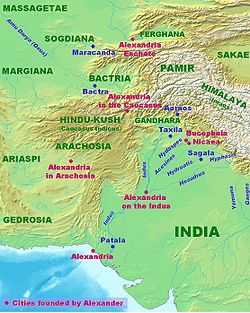Lasbela District
| Lasbela District | |
|---|---|
| District | |
 | |
| Country | Pakistan |
| Province | Balochistan |
| Capital | Uthal |
| Established | June 1954[1] |
| Government | |
| • Deputy Commissioner | Amir Sultan Tareen |
| • Commissioner | Dr.Muhammad Akbar Harifal |
| Area | |
| • Total | 12,574 km2 (4,855 sq mi) |
| Population (2005 Estimate) | |
| • Total | 312,917 |
| • Density | 29.02/km2 (75.2/sq mi) |
| Time zone | PST (UTC+5) |
| Number of Tehsils | 9 |
| Website | www.lasbeladistrictgovt.com |
Lasbela (Balochi: لسبیلہ) is a coastal district of Balochistan province of Pakistan. It became a separate district in Kalat Division on 30 June 1954. The name is derived from the words Las which in Sanskrit signifies a settlement or lived in or lively and Bela which means "A Sea's Shore" in Sanskrit and is also the name of the principal town of the district. Bela is the district headquarters. The district is divided into 9 Tehsil and 21 union councils.
Administration
The district of Lasbela is administratively subdivided into four tehsils, these are:[2]
History

The area now covered by the district was formerly the Las Bela state of the British Indian Empire, with internal autonomy from British India. From August 1947 to March 1948 it was fully independent under Ghulam Qadir Khan, then after he acceded to Pakistan it was one of the princely states of Pakistan. From 3 October 1952 to 14 October 1955, it state was a member of the Baluchistan States Union but retaining internal autonomy. That came to an end in 1955, when Las Bela was incorporated into the new West Pakistan province.
Geography
The main river is the Porali with its tributaries, Winder and Wirhab rivers.[3] Other rivers are the Phor and Hingol which rise in Awaran District before flowing through Lasbela on their way to the Arabian Sea.
Demographics
The population of Lasbela was estimated to be over 900,000 in 2013. In 1998, the overall population was 98.33% Muslim.[4] Of the remaining, 1.37% were Hindus and 0.14% Christian, with the rest belonging to various other religions.[4] In 1998, about 37% of the population resided in the urban areas.[4] In 1998, 22.3% of the population was literate with 32.16% of the males and 10.46% of the females.[4] The majority of population speaks either Sindhi or Baluchi. Much of the population also speaks a language called Lasi, which is derived from Sindhi or Jadgali.
Sites of interest
Shrines
- Shrine of Shah Bilawal
- Lahut-i-Lamakan
- Kumb Shrine
- Shireen and Farhad
- Sassi and Punnu
- Pir Fida Hussain
- Pir Moosiani
- Pir Mohiuddin
- Mai Gondrani
- Hinglaj
- [pir koonana]
- [pir shah bukhari]
- [pir meeran]
- [pir bukur]
- [Darga Baba Juman Shah] Uthal
- Nim Shaer Langah Uthal
- Peer Juma Langah Uthal
Historical buildings and archaeological sites
At Bela:
- Shah Jamai Mosque
- Tomb of General Muhammad ibn Haroon
- Tomb of Colonel Robert Sandeman
- Karia Pir
- Sassi Waro-Chodo (Sassi's Spring), near Paboni Naka, about 68 km from Karachi.[5]
- Bakkar Buthi, a small Harappan site located in the remote mountainous area to the east of the Las Bela plain.[6]
- Shehr-e-Roghan
See also
References
- ↑ History of Lasbela - Las Bela District Government
- ↑ Tehsils & Unions in the District of Lasbella - Government of Pakistan
- ↑ 1998 Population Census Report of Lasbela, Population Census Organisation, Government of Pakistan, Islamabad, 1999, Pg 2
- ↑ 4.0 4.1 4.2 4.3 1998 Population Census Report of Lasbela, Population Census Organisation, Government of Pakistan, Islamabad, 1999, Pg 24
- ↑ Archaeological sites and historical monuments - Lasbela Government
- ↑ Bakkar Buthi- Lasbela Government
Educational Inistitute
= at Uthal :
- Lasbela University of Water Agriculture and Marine Science
Others
External links
| ||||||||||
Coordinates: 25°45′N 66°35′E / 25.750°N 66.583°E